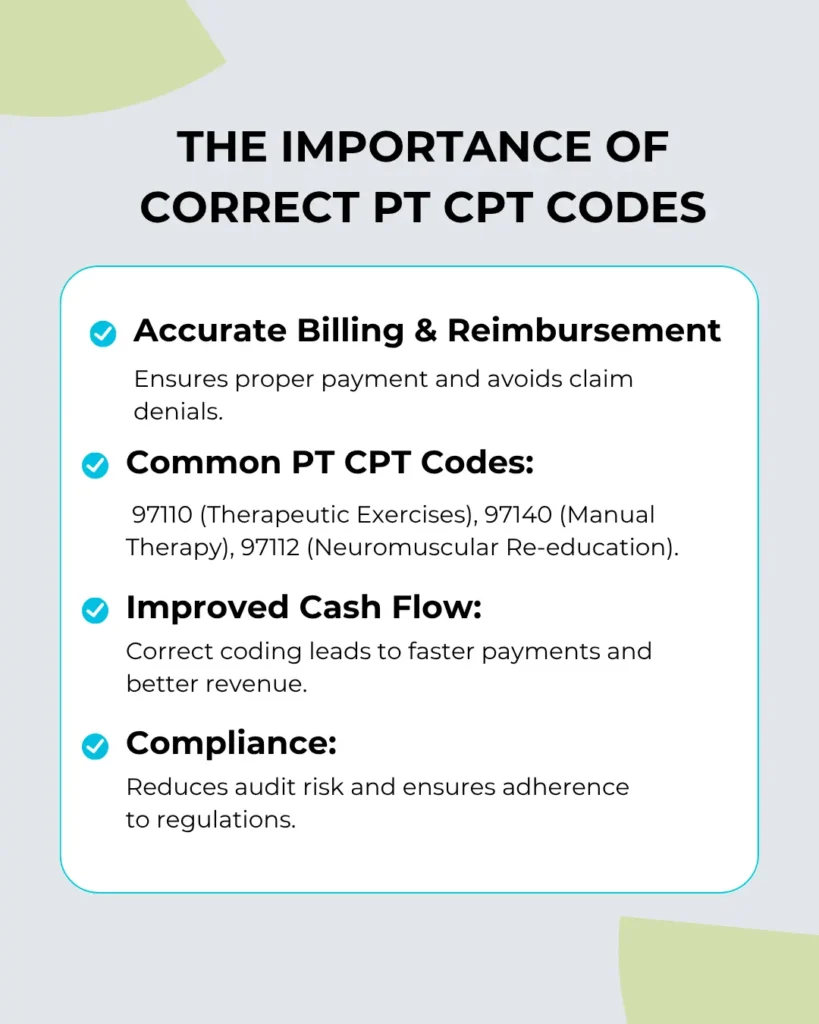One of the most important components of the billing process is using the correct CPT codes (Current Procedural Terminology codes). These codes play a significant role in ensuring that you are reimbursed appropriately for the services you provide.
We’ll explore what PT CPT codes are, how they improve billing accuracy, and why using them effectively can enhance your practice’s revenue cycle management (RCM). Whether you’re a physical therapist working on billing or collaborating with a medical billing company, understanding these codes will help streamline your billing process and reduce errors.

What Are PT CPT Codes?
PT CPT codes represent physical therapy services in medical billing and coding. Insurance companies, Medicare, Medicaid, and private payers use these codes to identify various physical therapy procedures. Each code corresponds to a specific treatment, procedure, or service provided by the physical therapist.
For example, physical therapists use CPT code 97110 for therapeutic exercises and CPT code 97140 for manual therapy. These codes ensure that physical therapy services are documented accurately and reimbursed appropriately.
Why Are PT CPT Codes Important?
1. Accurate Billing and Reimbursement
The primary reason why PT CPT codes are critical is that they ensure accurate billing and reimbursement for the services you provide. Insurance companies, including Medicare, rely on these codes to determine the appropriate reimbursement for physical therapy services.
- Incorrect coding can lead to denied claims and delayed payments.
- Accurate coding ensures that your services are billed correctly and reimbursed promptly.
By using the correct PT CPT codes, you are less likely to experience delays or denials in payment. This is especially important for physical therapy practices, where services are often billed separately and require precise documentation.
2. Compliance with Healthcare Regulations
Using the correct CPT codes ensures that your practice remains compliant with regulations set by Medicare, Medicaid, and private insurers. Incorrect coding can trigger audits, which can result in fines or loss of reimbursement. Compliance is essential for maintaining the financial health of your practice.
Common PT CPT Codes and Their Uses
1. CPT 97110 – Therapeutic Exercises
CPT 97110 is one of the most commonly used physical therapy CPT codes. This code is used for therapeutic exercises aimed at improving strength, endurance, flexibility, and range of motion.
- Example services:
- Strength training exercises
- Range of motion exercises
- Functional mobility exercises
- Strength training exercises
Therapists use CPT 97110 when working directly with patients to improve physical function. This code requires direct patient involvement during treatment.
2. CPT 97140 – Manual Therapy
CPT 97140 applies to manual therapy techniques such as joint mobilizations, soft tissue mobilization, and myofascial release. Manual therapy is a hands-on technique used to manipulate muscles and joints to alleviate pain and improve mobility.
- Example services:
- Joint mobilizations
- Soft tissue manipulation
- Myofascial release
- Joint mobilizations
This code is essential for billing when physical therapists perform hands-on procedures to treat musculoskeletal conditions.
3. CPT 97112 – Neuromuscular Re-education
CPT 97112 is used for neuromuscular re-education. This involves exercises and activities aimed at improving balance, coordination, posture, and functional movement.
- Example services:
- Balance training
- Postural training
- Proprioceptive training
- Balance training
Neuromuscular re-education is often used in patients recovering from neurological conditions or injuries that affect movement control.
How PT CPT Codes Impact
1. Reducing Claim Denials
In the world of Revenue Cycle Management (RCM), timely and accurate billing is crucial for a steady cash flow. By using the correct PT CPT codes, you reduce the likelihood of claim denials and delays. Incorrect or missing codes can cause your claim to be returned, requiring resubmission and delaying the payment process.
- Accurate codes help insurance carriers process claims faster and more efficiently.
2. Improving Cash Flow
When physical therapists use the correct CPT codes, they ensure full reimbursement for the services they provide. This means quicker payments and improved cash flow, which is crucial for sustaining your practice.
- Correct coding can lead to quicker processing and less time spent on administrative tasks like reworking claims.
3. Compliance and Audit Prevention
Proper use of PT CPT codes ensures your practice is compliant with healthcare regulations. Misuse of codes can result in audits, which can not only delay payments but also result in financial penalties.
Best Practices for Using PT CPT Codes
1. Regular Training for Billing Staff
Training your billing team on the correct PT CPT codes is critical to ensuring accurate billing. Regular training will help prevent errors and reduce the risk of claim denials.
2. Collaborate with a Company
Partnering with a medical billing company that specializes in physical therapy services can streamline your billing process. A professional billing company will:
- Ensure proper CPT code usage
- Submit claims on time
- Handle denials and rework claims efficiently
3. Review and Audit Claims Regularly
Conducting regular audits of your CPT coding practices can help catch mistakes before they turn into costly issues. By reviewing past claims, you can identify any recurring errors and train your staff to avoid them in the future.
Conclusion
Accurate PT CPT codes are essential for ensuring timely reimbursements, maintaining compliance, and optimizing your practice’s Revenue Cycle Management. By using the right codes, physical therapists can avoid claim denials, speed up the payment process, and ultimately improve their practice’s financial health.
If you’re looking to streamline your medical billing and coding process, consider working with a medical billing company that understands the intricacies of physical therapy billing.
FAQs
Q: What are the most common physical therapy CPT codes?
A: Common PT CPT codes include CPT 97110 (therapeutic exercises), CPT 97140 (manual therapy), and CPT 97112 (neuromuscular re-education).
Q: Why is accurate CPT coding important for physical therapy?
A: Accurate coding ensures proper reimbursement, reduces claim denials, and helps maintain compliance with insurance regulations.
Q: How can you help with PT CPT codes?
A: A medical billing company ensures accurate CPT coding, handles claim submission, and tracks denials, allowing for quicker reimbursements and improved financial health.







